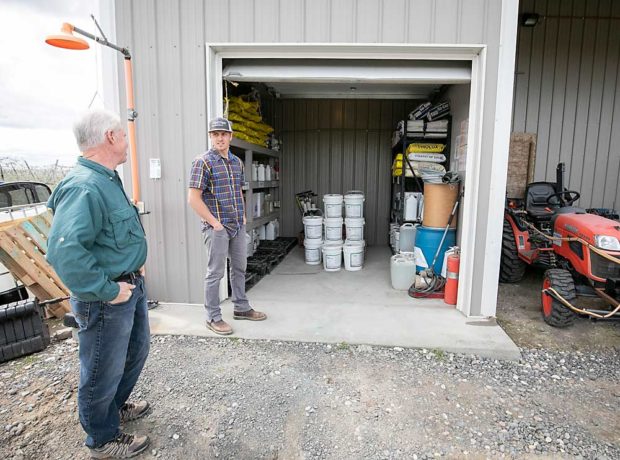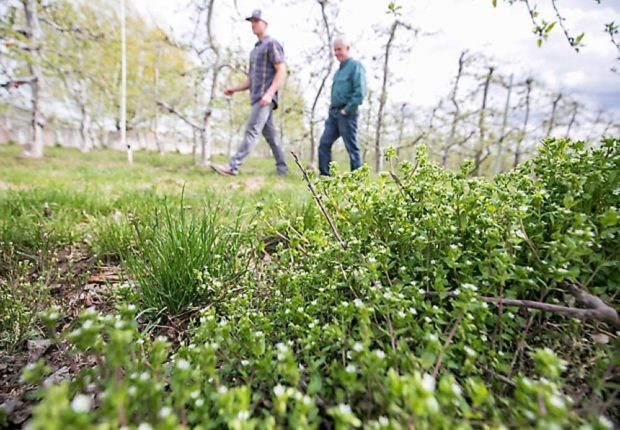
On a sunny April day near Pasco, Washington, organic field inspector Del Long scrutinized the space between grower Conner Sullivan’s old block of Index cherry trees — tall, widely spaced and conventionally grown — and a block of Gala apples transitioning to organic.
“You could get away with one row of buffer,” Long said, as he and Sullivan discussed how many Gala rows should remain conventional as a buffer against spray drift. Then again, he might need two. In the end, Long suggested Sullivan try one row first and promised he would return shortly before harvest to sample fruit for pesticide residue to make sure it was working.
Sullivan encountered such collaborative attitudes from the Washington State Department of Agriculture as he worked through the transition process at CC Sullivan Farms. He was pleasantly surprised.
“I thought it was going to be a pain in the butt,” said Sullivan, who is leading the transition effort of the 50-acre orchard he owns with his older cousin, Clint Sullivan.
The process was arduous, no doubt, he said. Reams of paperwork and records were required. But he was braced to butt heads with an adversarial bureaucracy and it never happened. Office staff at the WSDA have returned calls and emails promptly, while Long, the inspector, was easy to work with, Sullivan said.
“I’ve called their office a ton of times,” he said. “Sometimes it’s a stupid question.”
Brenda Book, the state’s organic program manager, is not surprised, at all. “I think the majority of our interactions go well,” she said.
People often assume the worst about administrative state agencies, she said — they’re slow, uncompromising, faceless and unaccountable.
For one thing, the organic program is voluntary. And the process doesn’t involve a black-and-white checklist, but rather is designed to take into account the entire culture of the farm, giving “points” for biodiversity in orchard alley cover crops, the types of bug traps used, how well a chemical shed is organized and, as time goes on, how well the farm continues to improve.
“It really isn’t a check box sort of a system,” she said.
Certified Organic is a level of standard written by the U.S. Department of Agriculture, which contracts 80 agencies across the nation to inspect and implement that standard. WSDA is one of only 14 state agencies to take on that work. The rest are private.

Making the transition
The Sullivans decided to go organic after hearing of high returns from their neighbors. They were at a period of transition anyway. The two purchased the 50-acre farm in 2015 from their grandmother: about 20 acres of apples, 15 acres of apricots, 10 acres of peaches and nectarines and about 2 acres of cherries.
Conner Sullivan was tapped to lead the organic transition for nearly their entire farm — all but the cherries — as well as 7 apple acres belonging to his father, Patrick Sullivan, who owns an adjacent farm.
To qualify for organic, the farm must prove it has used only certified organic inputs for three years. The WSDA works with the applicant from Day 1 of that so-called “transition” period to deal with red flags as they pop up.
The process was not easy or cheap, Sullivan said. He figures his costs jumped 30 to 50 percent per acre over conventional farming. He also spent hours rounding up details. They wanted to know if he planted organic grasses for the drive-row or if he has irrigation shut-off valves between organic and conventional blocks.
“When I first sent in my initial paperwork, I mean it was a lot of stuff,” he said. “They want records of everything, rightly so, I guess.”
But he considered that back-and-forth communication of emails, phone calls and letters transparent and clear, at least in his case.
When Long finally came for his final inspection in April, he spent all day at Sullivan’s farm, not even stopping for lunch. Most of the time he pored over paperwork in the office. Then, Long checked out the overall orderliness of Sullivan’s chemical shed, to ensure items were properly labeled and stored.

Then came a pickup tour of the property. The two got out of Sullivan’s truck to walk through a Gala block, where Long made note of the biodiversity in the drive-row cover grasses, codling moth pheromone emitters and solar-powered bug zappers so powerful they occasionally kill small birds. Long even took some photos of one of them for future reference.
Every inspector’s goal is to find the sweet spot between cooperating with the applying grower without advocacy or advice, Long said. He doesn’t make the final decision whether Sullivan is certified. He writes a report and a reviewer in Olympia, Washington, does that within about two months of the visit. Sullivan received his certificate in early June.
Sullivan advised other growers considering the switch to do a lot of homework and map out timing carefully. If you are going to fumigate, do it early — perhaps before you start your three-year transition period. If you’re planting, find certified organic trees. Both of those things could bump up the start date on your transition and, therefore, your certification year.
“A lot of those things we’ve just been learning along the way,” he said. •
—by Ross Courtney






Leave A Comment